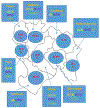Monitoring Indicators of Universal Access to Accessible and Safe Anesthetic and Surgical Care in a Peruvian Region: An Ambispective Study
- PMID: 36403406
- PMCID: PMC10118244
- DOI: 10.1016/j.jss.2022.10.024
Monitoring Indicators of Universal Access to Accessible and Safe Anesthetic and Surgical Care in a Peruvian Region: An Ambispective Study
Abstract
Introduction: The Lancet Commission on Global Surgery indicators for monitoring anesthetic and surgical care allow the identification of access barriers, evaluate the safety of surgeries, facilitate planning, and assess changes over time. The primary objective was to measure these indicators in all health facilities of a Peruvian region in 2020.
Methods: This was an ambispective observational study to measure the anesthetic and surgical care indicators in Piura, a region in Peru, between January 2020 and June 2021. Public and private health facilities in the Piura region that performed surgical care or had specialists from any surgical specialty participated in the study. Data were collected from all regional health facilities that provided surgical care to estimate the density of surgical workforce. Likewise, the percentage of the population with access to an operating room within 2 h was estimated using georeferenced tools. Finally, a public database was accessed to determine the surgical volume, the percentage of the regional population protected with health insurance.
Results: In 2020, 88.4% of the inhabitants of this Peruvian region had access to timely essential surgery. There were 18.4 surgical specialists and 1174 surgeries per 100,000 populations, and 91% of the population had health insurance. In addition, there was a rate of 2.1 working operating rooms per 100,000 inhabitants in 2021.
Conclusions: This Peruvian region presented an increasing trend with respect to the population's access to essential and timely surgical care, and health insurance coverage. However, the workforce distribution was inequitable among the provinces of the region, the surgical volume was reduced, and timely access was hindered because of the SARS-CoV-2 pandemic.
Keywords: Anesthesia; Health services accessibility; Health workforce; Peru; Surgery; Universal health insurance.
Copyright © 2022 Elsevier Inc. All rights reserved.
Conflict of interest statement
Disclosure
The authors have no conflicts of interest. The content is solely the responsibility of the authors and does not necessarily represent the official views of the Health Ministry of Peru and Social Security of Health of Peru-EsSalud.
Figures

Similar articles
-
Timely Access to Essential Surgery, Surgical Workforce, and Surgical Volume: Global Surgery Indicators in Mexico.Glob Health Sci Pract. 2023 Feb 28;11(1):e2100745. doi: 10.9745/GHSP-D-21-00745. Print 2023 Feb 28. Glob Health Sci Pract. 2023. PMID: 36853648 Free PMC article.
-
Universal access to safe, affordable, timely surgical and anaesthetic care in Papua New Guinea: the six global health indicators.ANZ J Surg. 2020 Oct;90(10):1903-1909. doi: 10.1111/ans.16148. Epub 2020 Jul 20. ANZ J Surg. 2020. PMID: 33710739
-
Surgical care and trauma patients capacity in Piura, Perú - Cross-sectional study.Rev Colomb Anestesiol. 2023 Feb 2;51(1):e1058. doi: 10.5554/22562087.e1058. Epub 2022 Dec 15. Rev Colomb Anestesiol. 2023. PMID: 37904840 Free PMC article.
-
Optimizing the Global Nursing Workforce to Ensure Universal Palliative Care Access and Alleviate Serious Health-Related Suffering Worldwide.J Pain Symptom Manage. 2022 Feb;63(2):e224-e236. doi: 10.1016/j.jpainsymman.2021.07.014. Epub 2021 Jul 29. J Pain Symptom Manage. 2022. PMID: 34332044 Free PMC article. Review.
-
The Global Initiative for Children's Surgery: Optimal Resources for Improving Care.Eur J Pediatr Surg. 2018 Feb;28(1):51-59. doi: 10.1055/s-0037-1604399. Epub 2017 Aug 14. Eur J Pediatr Surg. 2018. PMID: 28806850
References
-
- Weiser TG, Makary MA, Haynes AB, et al. Standardised metrics for global surgical surveillance. Lancet. 2009;374:1113–1117. - PubMed
-
- Watters DA, Guest GD, Tangi V, Shrime MG, Meara JG. Global surgery system strengthening: it is all about the right metrics. Anesth Analg. 2018;126:1329–1339. - PubMed
-
- Weiser TG, Makasa EM, Gelb AW. Improving perioperative outcomes in low-resource countries: it can’t be fixed without data. Can J Anaesth. 2015;62:1239–1243. - PubMed
-
- Meara JG, Leather AJM, Hagander L, et al. Global Surgery 2030: evidence and solutions for achieving health, welfare, and economic development. Lancet. 2015;386:569–624. - PubMed
-
- World Health Organization. WHO | World Health Organization Emergency and essential surgical care. Resolution WHA68.15. Emergency and essential surgical care. World Health Organization. 2020. Available at: https://www.who.int/surgery/wha-eb/en/. Accessed April 20, 2020.
Publication types
MeSH terms
Substances
Grants and funding
LinkOut - more resources
Full Text Sources
Medical
Miscellaneous

